QEasingCurve¶
The
QEasingCurveclass provides easing curves for controlling animation. More…

New in version 4.6.
Synopsis¶
Functions¶
def
__eq__(other)def
__ne__(other)def
addCubicBezierSegment(c1, c2, endPoint)def
addTCBSegment(nextPoint, t, c, b)def
amplitude()def
customType()def
overshoot()def
period()def
setAmplitude(amplitude)def
setCustomType(arg__1)def
setOvershoot(overshoot)def
setPeriod(period)def
setType(type)def
swap(other)def
toCubicSpline()def
type()def
valueForProgress(progress)
Detailed Description¶
Easing curves describe a function that controls how the speed of the interpolation between 0 and 1 should be. Easing curves allow transitions from one value to another to appear more natural than a simple constant speed would allow. The
QEasingCurveclass is usually used in conjunction with theQVariantAnimationandQPropertyAnimationclasses but can be used on its own. It is usually used to accelerate the interpolation from zero velocity (ease in) or decelerate to zero velocity (ease out). Ease in and ease out can also be combined in the same easing curve.To calculate the speed of the interpolation, the easing curve provides the function
valueForProgress(), where theprogressargument specifies the progress of the interpolation: 0 is the start value of the interpolation, 1 is the end value of the interpolation. The returned value is the effective progress of the interpolation. If the returned value is the same as the input value for all input values the easing curve is a linear curve. This is the default behaviour.For example,
QEasingCurve easing(QEasingCurve::InOutQuad); for (qreal t = 0.0; t < 1.0; t += 0.1) qWarning() << "Effective progress" << t << "is" << easing.valueForProgress(t);will print the effective progress of the interpolation between 0 and 1.
When using a
QPropertyAnimation, the associated easing curve will be used to control the progress of the interpolation between startValue and endValue:QPropertyAnimation animation; animation.setStartValue(0); animation.setEndValue(1000); animation.setDuration(1000); animation.setEasingCurve(QEasingCurve::InOutQuad);The ability to set an amplitude, overshoot, or period depends on the
QEasingCurvetype. Amplitude access is available to curves that behave as springs such as elastic and bounce curves. Changing the amplitude changes the height of the curve. Period access is only available to elastic curves and setting a higher period slows the rate of bounce. Only curves that have “boomerang” behaviors such as theInBack,OutBack,InOutBack, andOutInBackhave overshoot settings. These curves will interpolate beyond the end points and return to the end point, acting similar to a boomerang.The Easing Curves Example contains samples of
QEasingCurvetypes and lets you change the curve settings.
- class PySide2.QtCore.QEasingCurve([type=Linear])¶
PySide2.QtCore.QEasingCurve(other)
- param type:
- param other:
Constructs an easing curve of the given
type.
- PySide2.QtCore.QEasingCurve.Type¶
The type of easing curve.
Constant
Description
QEasingCurve.Linear
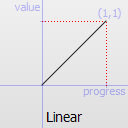
Constant
Description
QEasingCurve.InQuad
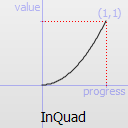
Constant
Description
QEasingCurve.OutQuad
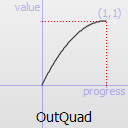
Constant
Description
QEasingCurve.InOutQuad
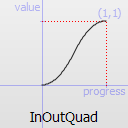
Constant
Description
QEasingCurve.OutInQuad
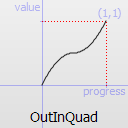
Constant
Description
QEasingCurve.InCubic
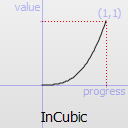
Constant
Description
QEasingCurve.OutCubic
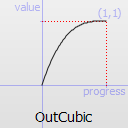
Constant
Description
QEasingCurve.InOutCubic
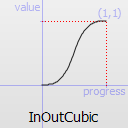
Constant
Description
QEasingCurve.OutInCubic
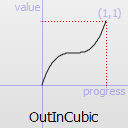
Constant
Description
QEasingCurve.InQuart
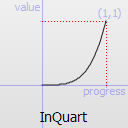
Constant
Description
QEasingCurve.OutQuart
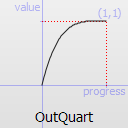
Constant
Description
QEasingCurve.InOutQuart
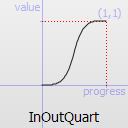
Constant
Description
QEasingCurve.OutInQuart
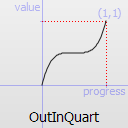
Constant
Description
QEasingCurve.InQuint
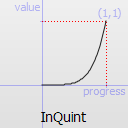
Constant
Description
QEasingCurve.OutQuint
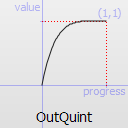
Constant
Description
QEasingCurve.InOutQuint
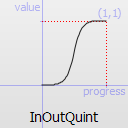
Constant
Description
QEasingCurve.OutInQuint
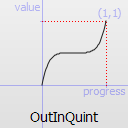
Constant
Description
QEasingCurve.InSine

Constant
Description
QEasingCurve.OutSine
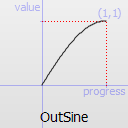
Constant
Description
QEasingCurve.InOutSine
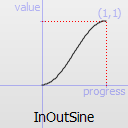
Constant
Description
QEasingCurve.OutInSine

Constant
Description
QEasingCurve.InExpo
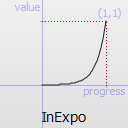
Constant
Description
QEasingCurve.OutExpo

Constant
Description
QEasingCurve.InOutExpo
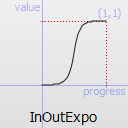
Constant
Description
QEasingCurve.OutInExpo
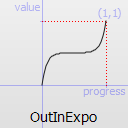
Constant
Description
QEasingCurve.InCirc
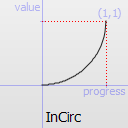
Constant
Description
QEasingCurve.OutCirc

Constant
Description
QEasingCurve.InOutCirc
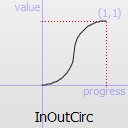
Constant
Description
QEasingCurve.OutInCirc
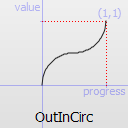
Constant
Description
QEasingCurve.InElastic

- amplitude**period
Constant
Description
QEasingCurve.OutElastic
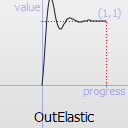
- amplitude**period
Constant
Description
QEasingCurve.InOutElastic
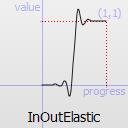
Constant
Description
QEasingCurve.OutInElastic
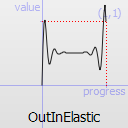
Constant
Description
QEasingCurve.InBack
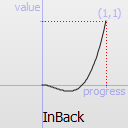
Constant
Description
QEasingCurve.OutBack
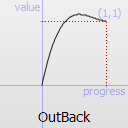
Constant
Description
QEasingCurve.InOutBack
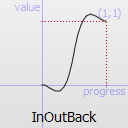
Constant
Description
QEasingCurve.OutInBack

Constant
Description
QEasingCurve.InBounce
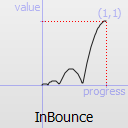
Constant
Description
QEasingCurve.OutBounce
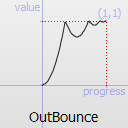
Constant
Description
QEasingCurve.InOutBounce
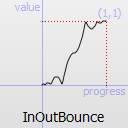
Constant
Description
QEasingCurve.OutInBounce
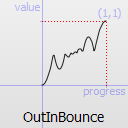
Constant
Description
QEasingCurve.BezierSpline
Allows defining a custom easing curve using a cubic bezier spline
QEasingCurve.TCBSpline
Allows defining a custom easing curve using a TCB spline
QEasingCurve.Custom
This is returned if the user specified a custom curve type with
setCustomType(). Note that you cannot callsetType()with this value, buttype()can return it.See also
- PySide2.QtCore.QEasingCurve.addCubicBezierSegment(c1, c2, endPoint)¶
- Parameters:
endPoint –
PySide2.QtCore.QPointF
Adds a segment of a cubic bezier spline to define a custom easing curve. It is only applicable if
type()isBezierSpline. Note that the spline implicitly starts at (0.0, 0.0) and has to end at (1.0, 1.0) to be a valid easing curve.c1andc2are the control points used for drawing the curve.endPointis the endpoint of the curve.
- PySide2.QtCore.QEasingCurve.addTCBSegment(nextPoint, t, c, b)¶
- Parameters:
nextPoint –
PySide2.QtCore.QPointFt – float
c – float
b – float
Adds a segment of a TCB bezier spline to define a custom easing curve. It is only applicable if
type()isTCBSpline. The spline has to start explicitly at (0.0, 0.0) and has to end at (1.0, 1.0) to be a valid easing curve. The tensiontchanges the length of the tangent vector. The continuitycchanges the sharpness in change between the tangents. The biasbchanges the direction of the tangent vector.nextPointis the sample position. All three parameters are valid between -1 and 1 and define the tangent of the control point. If all three parameters are 0 the resulting spline is a Catmull-Rom spline. The begin and endpoint always have a bias of -1 and 1, since the outer tangent is not defined.
- PySide2.QtCore.QEasingCurve.amplitude()¶
- Return type:
float
Returns the amplitude. This is not applicable for all curve types. It is only applicable for bounce and elastic curves (curves of
type()InBounce,OutBounce,InOutBounce,OutInBounce,InElastic,OutElastic,InOutElasticorOutInElastic).See also
- PySide2.QtCore.QEasingCurve.customType()¶
- Return type:
object
- PySide2.QtCore.QEasingCurve.__ne__(other)¶
- Parameters:
other –
PySide2.QtCore.QEasingCurve- Return type:
bool
Compare this easing curve with
otherand returnstrueif they are not equal. It will also compare the properties of a curve.See also
operator==()
- PySide2.QtCore.QEasingCurve.__eq__(other)¶
- Parameters:
other –
PySide2.QtCore.QEasingCurve- Return type:
bool
Compare this easing curve with
otherand returnstrueif they are equal. It will also compare the properties of a curve.
- PySide2.QtCore.QEasingCurve.overshoot()¶
- Return type:
float
Returns the overshoot. This is not applicable for all curve types. It is only applicable if
type()isInBack,OutBack,InOutBackorOutInBack.See also
- PySide2.QtCore.QEasingCurve.period()¶
- Return type:
float
Returns the period. This is not applicable for all curve types. It is only applicable if
type()isInElastic,OutElastic,InOutElasticorOutInElastic.See also
- PySide2.QtCore.QEasingCurve.setAmplitude(amplitude)¶
- Parameters:
amplitude – float
Sets the amplitude to
amplitude.This will set the amplitude of the bounce or the amplitude of the elastic “spring” effect. The higher the number, the higher the amplitude.
See also
- PySide2.QtCore.QEasingCurve.setCustomType(arg__1)¶
- Parameters:
arg__1 – object
- PySide2.QtCore.QEasingCurve.setOvershoot(overshoot)¶
- Parameters:
overshoot – float
Sets the overshoot to
overshoot.0 produces no overshoot, and the default value of 1.70158 produces an overshoot of 10 percent.
See also
- PySide2.QtCore.QEasingCurve.setPeriod(period)¶
- Parameters:
period – float
Sets the period to
period. Setting a small period value will give a high frequency of the curve. A large period will give it a small frequency.See also
- PySide2.QtCore.QEasingCurve.setType(type)¶
- Parameters:
type –
Type
Sets the type of the easing curve to
type.See also
- PySide2.QtCore.QEasingCurve.swap(other)¶
- Parameters:
other –
PySide2.QtCore.QEasingCurve
Swaps curve
otherwith this curve. This operation is very fast and never fails.
- PySide2.QtCore.QEasingCurve.toCubicSpline()¶
- Return type:
Returns the
cubicBezierSplinethat defines a custom easing curve. If the easing curve does not have a custom bezier easing curve the list is empty.
- PySide2.QtCore.QEasingCurve.type()¶
- Return type:
Returns the type of the easing curve.
See also
- PySide2.QtCore.QEasingCurve.valueForProgress(progress)¶
- Parameters:
progress – float
- Return type:
float
Return the effective progress for the easing curve at
progress. Whereasprogressmust be between 0 and 1, the returned effective progress can be outside those bounds. For example,InBackwill return negative values in the beginning of the function.
© 2022 The Qt Company Ltd. Documentation contributions included herein are the copyrights of their respective owners. The documentation provided herein is licensed under the terms of the GNU Free Documentation License version 1.3 as published by the Free Software Foundation. Qt and respective logos are trademarks of The Qt Company Ltd. in Finland and/or other countries worldwide. All other trademarks are property of their respective owners.
